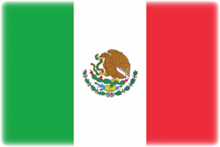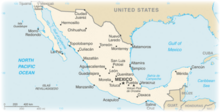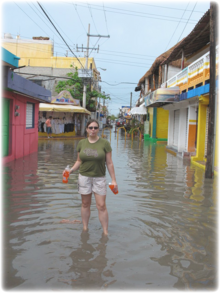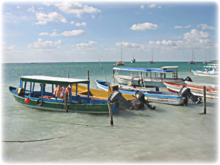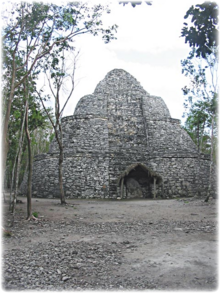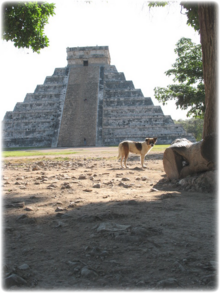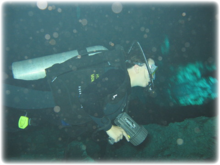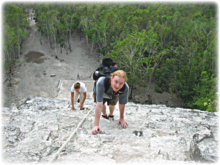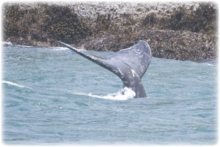
General Information
| Languages : | Spanish |
| Currency : | Mexican Peso (MXN) |
| Time Zone : | EST -1hrs |
| Capital City : | Mexico City |
| Population : | 108 Million |
| Government : | Federal Republic |
| Total Area : | 761,605 mi² |
| Climate : | Varies from tropical to desert |
| National Holidays: | Independence Day, 16 September |
| Additional Info: | The most notable tourist draws are the ancient Meso-American ruins, and popular beach resorts. |
Destination Activities
Activity Details
A visit to the Yucatan
I don't know hardly anything about Cancun (not only does it sound like a commercial nightmare on a normal day, but Hurricane Wilma came through and sat on Cancun for 28 hours just one week before we arrived there) but the rest of the Yucatan that I visited in a 7-day time frame was wonderful.
Isla Mujeres and getting there
We started our fabulous trip from plane to bus to taxi to ferry to ... the best part which was a bike taxi. The bike taxi was a large old metal framed tricycle with a massive basket on the front, pedaled by Fidel. He put our back packs in his basket and we walked through the quiet little town on Isla Mujeres off the coast from Cancun to our hotel. Isla Mujeres is said to be a backpacker's paradise but for me I can't see how it isn't a paradise to everyone. It is simple traditional living. It's hard to believe that one ferry ride away is the mad haven for spring breakers, Cancun.
Walking through the brightly painted building-lined streets of downtown is amazing. Everyone seemed to know everyone and Fidel told us the best places to eat, to rent bikes, and to check out the beach. The marvel of Fidel, that both me and my husband admire to this day, is how we told him the day we were leaving but that was all. The morning we sadly departed this magical island, he was waiting downstairs to take us back to the ferry, and he had just got there. We stayed at the Sea Hawk Inn, which was also a local dive shop who arranged the scuba diving we did on the island. The room was one of the nicest rooms I have stayed in and even came with a resident cat, who we called Don Gato, although she was a girl. We had steps leading up to the roof where we had great island views and the stargazing was fantastic.
They recommend this island as a day trip for Cancun visitors but we stayed for 4 days and were sad to leave. In the mornings we joined Ariel, the dive master, on some dives off his little boat, in the afternoons we walked to the beach, or hired mopeds and explored all 12 miles of Isla Mujeres, or just hung out in the little town. The town is full of what appeared to be pretty well behaved stray dogs. We made friends with several - enough to fill a calendar of Mexican dogs that brought smiles to our faces for the whole next year. One great day a pack of 3 dogs lead us down to the beach and played in the sand with us until about 5pm when they all left at the same time - presumably someone was feeding them. When we visited there was quite some destruction from the hurricane and it was very quiet. It's hard to say what it is like normally but I heard that it usually a busy place in the day and quiets down in the evenings.
The diving was also affected by the hurricane - why we never went to Cozumel which suffered a great deal of reef damage and was pretty much closed down to the diver - but we did get to see our dive master spear an octopus and then later eat it in a beautifully made ceviche.
Tulum
Leaving the calm pleasantness of the island behind us, we next rented a car and headed along the coastal road to Tulum. We stayed in a cool cabana in a spa hotel (very usual for the area) that appeared to have a nudist beach right in front of the bar! The cabana was cool although the evening weather was cool and pleasant in November, so maybe they would be less pleasant in the summer months. There are some great things about our stay in Tulum - haggling with the marketers for some very unique Mexican Christmas presents for the family, having a Mayan clay massage and cleansing your body (while naked) in the sea afterwards, and of course the amazing Mayan ruins and the hidden Cenotes (see Scuba Diving).
We visited the Tulum city ruins too late in the day for a guided tour, which is definitely recommended for big fans of the culture - but we did get some beautiful sunset views as the temple overlooks the Caribbean Sea. Tulum is the site of a Pre-Columbian Maya walled city serving as a major port for Coba (coming next). The ruins are located on 39-ft cliffs, the state of Quintana Roo. One of the best-preserved coastal Maya sites, this is relatively compact (compared with many other Maya sites in the vicinity). It was very quiet at the time of year we visited but I heard that it is the popular spot for cruise ships and for day trippers from Cancun.
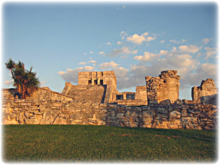
Coba
The pot-hole-filled ride from Tulum to Chichen Itza via Coba is mighty impressive. The road we traveled on was light in traffic so several miles ahead you are able to guess where the pot holes are by the odd maneuvers you see cars doing in front of your. Coba is a large ruined city of the Pre-Columbian Maya civilization, located in the state of Quintana Roo, Mexico. It is located about 56 miles east of the Maya site of Chichen Itza, and 27 miles northwest of the site of Tulum. Coba is located around two lagoons. Coba is one of the less visited Mayan sites even though it has the largest pyramid structure in the Yucatan. The site is quite spread out so some tourists opt to rent bikes around this site, which upon choosing the walking path, I do advise this for future travelers. Although ambling along the paths was fun. We climbed to the top of the largest Castillo and looked over the vast jungle around us - the only things that are visible among this enormous mass of tangle are the scattered ruins of Coba, peeping through the trees.
Chichen Itza
We arrived at our hotel near Chichen Itza in time to have a shower, watch some Mexican TV, then head over to the most famous of the ruins in the Yucatan to see the light show before spending the following day there as well. The light show is interesting although a wee bit lack luster if you have gotten used to US kind of entertainment - but it is a nice historic feel, even if the lights themselves feel a bit unadventurous. The site contains many fine stone buildings in various states of preservation; the buildings were formerly used as temples, palaces, stages, markets, baths, and ballcourts. Dominating the center of Chichen is the Temple of Kukulcan (the Maya name for Quetzalcoatl), often referred to as "El Castillo" (the castle). This step pyramid has a ground plan of square terraces with stairways up each of the 4 sides to the temple on top. On the spring and fall equinox, at the rising and setting of the sun, the corner of the structure casts a shadow in the shape of a plumed serpent - Kukulcan, or Quetzalcoatl - along the side of the North staircase. On these two days, the shadows from the corner tiers slither down the northern side of the pyramid with the sun's movement. There are many structures to check out here and with a guide you could probably spend a day or more learning about them all. We are more the lazy travelers and just took great photos and played around the ruins!
Our final evening was spent in the Hurricane-ravaged Cancun before our early flight out the next day. What we saw were a lot of American-style restaurants and shops. However, we did find a market, still catering to tourists but happy to see some!, and found a great place for our last Mexican meal of our travels.
Ecotourism
With Mexico, there are eco-tourism destinations everywhere. The best bet is to pick your main location or city that you want to center your tour around and go from there. Some ideas are provided below:
Huatulco - a good geographical location on the southern coast of Oaxaca state. The best time to visit is between November and February when the temperatures are actually quite comfortable. Like Cancun, it is one of the Mexican governments tourist projects that it hopes will grow but right now it's a long way from being there. Huatulco's tourism industry is centered around its nine bays, with thirty-six beaches, many of which are accessible only by boat. With the help of local guides and businesses, one can explore the beaches and bays in relative privacy, or dive to see tropical fish and coral. The peak season for foreign tourism is typically from December to April. Sightseeing includes popular bay tours, ecological excursions, beach combing, and horseback riding. The sports scene offers tennis, every imaginable water sport, and golf. Huatulco also has some of the clearest water on Mexico's Pacific coast, and there are some great diving and snorkeling spots.
La Paz - capital of Baja Sur, it is a traditional Mexican city, a port city with fishing as its main industry which has managed to escape becoming one of Baja Sur's Americanized tourist destinations. During the summer the cooling Coromuel winds, a weather phenomenon unique to the La Paz area, blow during the night from the Pacific over the Peninsula and into the Bay of La Paz. Eco-Tourism is by far its major source of tourists income as people come to enjoy its marine wonders, as well as its diverse and often unique terrestrial species endemic to the region. All of the islands in the Gulf of California are now under UNESCO protection as World Heritage Bio-Reserves and the Espiritu Santos Islands group, which borders the south eastern portion of the Bay of La Paz and are considered the crown jewels of the islands of the Gulf (also referred to as the Sea of Cortez/Mar de Cortes), the primary tourist destination of the area. Its diving, snorkeling, and kayaking are considered second to none.
Teotihuacan - at its height in the first half of the 1st millennium CE, it was the largest pre-Columbian city in the Americas. Knowledge of the huge ruins of Teotihuacan was never lost. After the fall of the city, various squatters lived on the site. During Aztec times, the city was a place of pilgrimage and identified with the myth of Tollan, the place where the sun was created. Teotihuacan astonished the Spanish conquistadores during the post-conquest era. Today Teotihuacan is one of the most noted archaeological attractions in Mexico.
Palenque - thought to have its origins some time around the first century and continued to flourish until around 900 AD which corresponds to the time when the Yucatan was scourged by a drought that lasted for years, drying up even the largest lakes and killing everything that remained. Palenque is a Mayan archeological site near the Usumacinta River in the Mexican state of Chiapas. Palenque is perhaps the most studied and written about of Maya sites.
The city of San Cristobal de las Casas rests in the mountains at an elevation of 7,000 feet, or 2,100 meters. This makes San Cristobal a great summer destination with its cooler temperatures, and in the winter, San Cristobal is one of the few places in Mexico that actually require a jacket.
Scuba Diving including Hidden Cenotes
A cenote is, in the Yucatan Peninsula, a type of freshwater-filled sinkhole. There are more to see at the Chichen Itza Mayan ruin site - but for scuba divers the best kind are the hidden ones just outside Tulum. Cenotes provide access to many extensive underwater cave systems, such as Nohoch Nah Chich and Dos Ojos. The cenotes have attracted cave divers and there are organized efforts to explore and map the underwater systems.
Dos Ojos is a cenote near Tulum, Mexico. It is one of the entrances to the extensive Nohoch Nah Chich underwater cave system. Dos Ojos was featured in a 2002 IMAX film, 'Journey into Amazing Caves.' Water temperature is typically from 72 to 80 degrees and the maximum depth is approximately 30 feet, with the majority of the dives at 15 - 20 feet.
We arranged with a local company to pick us up at our hotel. They collected us and then drove us down a beaten jungle path in a battered open air truck to the dive site (most fun). Of course the cenotes had their own local stray dog for everyone to love on and feed their sandwiches to. Once garbed up (I had a 3mm thick suit on and the temperature was fine), we headed down 3 vertical ladders into a large cave. Our dive master, Norwegian Bob, explained some of the additional features involved in cave diving - mainly that the weights are different (usually about 1/3 of that used in ocean diving) and about some underwater signals he would use. It seemed scary but once we got going it was just so visually stunning, I forgot to be nervous. At first the water seemed cold but it was most refreshing and crystal clear.
The cavern dive we did was broken into two 45-minute dives with a 60-minute surface interval, with the second dive going into the Bat Cave, which is also used for snorkeling. Visibility was amazing - the only thing hindering your endless views being the turns and twists of the caves. Once in the cenotes, we saw stalagmites and stalactites in impressive formations, lots of little freshwater fish and a couple of freshwater shrimp too. The most beautiful aspect of these dives for me were the effects of the natural light creeping in from somewhere on the surface of the pools - it cast an emerald green over the rock formations that was really quite stunning, although hard to catch well on camera.
This is also a great place to really practice buoyancy as touching any of the rock formations is not cool so as you navigate up and down and round and about, you need to really work the breathing - but its fun too - especially when you get quite good. Relying on a torch/flashlight for sight is also interesting, if you haven't completed a night dive before. At times you will go through some quite narrow spaces for you and your dive gear so be prepared if you think you might be a little concerned about small spaces.
When you are done and head back to the main dive center, expect to find more dogs to play with as you settle your bill and say good bye to the helpful staff!
Hiking
For an exciting hiking trip, head to the Sierra de la Laguna, a mountain range on the Baja California Peninsula of Mexico. It lies at the southern end of the peninsula in the state of Baja California Sur, and is the southernmost range of the Peninsular Ranges. Start your hike close to sea level and climb to 6,600 ft altitude - the highest point in the sierra, from where you can enjoy views of both seas, the pacific sea and the gulf of California. Use Huerta los Mangos as your start and finish destination. Be especially careful when hiking in Baja's desert lands. You will need twice as much water since it is so hot and dry. Good sun protection is also essential. Make sure to have good footwear, as you may encounter a rocky terrain in some places. The temperature cools down quite a bit at night, so make sure to have enough layers of clothing to be comfortable. Many advise starting the hikes very early in the morning to avoid too much exposure to the sun.
Kayaking
Where to go if you love sea kayaking AND love whales? I know, I know - that sounds too good to be true and instead of reading about it, you wish you were there. Well read up and get planning. The rugged Baja Peninsula of Mexico is now the most popular winter paddling destination in North America. The miles of wilderness coast that fringe the Baja Peninsula are ideal for exploration by sea kayak. This elaborate shoreline offers more than just striking scenery and warm, gorgeous weather. There's the brilliant whale watching too. A lot of companies offer great sea kayaking tours in addition to separate motorboat guided whale watching tours, which are great for people who like one or the other. But if you want the immense joy of coming across a whale while in your kayak, its best to go for a longer trip where you will have more opportunity to sight these majestic creatures. A multi-day wilderness camping and kayak trip, for example, in the sheltered gray whale lagoons of Magdalena Bay is a great plan. This bay is particularly noted for the seasonal migration of the California Gray Whales that come here during winter to mate. The bay is also popular for commercial and sports fishing. Nearby mangrove swamps provide sanctuaries for sea birds. The bay includes the small fishing port of San Carlos, as well as Puerto Lopez Mateos, which provides a good place to observe the whales.
Another great idea for a kayaking trip in Baja is to explore the Sea of Cortez (Loreto Bay). Desert islands and tranquil waters with a fantastic backdrop of the Sierra Giganta Mountains to accompany you on your travels. This part of the country is a photographer's paradise and a great time to really experience the thrill of sea kayaking with amazing rewards on every island. These waters offer exceptional opportunities for viewing dolphins, sea lions and blue and fin whales in the wild. High-flying frigate birds, blue-footed boobies and squadrons of pelicans are your companions as you kayak past manta rays and brightly colored fish on any of our Sea of Cortez sea kayaking expeditions.
For whale watching the best time is February and March. Most tour operators offer additional trips this time of year to include the best opportunities to see the beautiful whales as they head down to their favorite breading spot. Baja California of Mexico is reputedly the most cloud-free area in the world. The only weather-related problem that you could encounter is high winds. Daytime temperatures are best described as "perfect" with highs between the upper 60s and upper 80s. Rarely, cooler weather can strike during the winter months, especially along the Pacific Coast, when the night air has the potential for becoming a bit nippy, requiring a warm hat and three-season sleeping bag.
Photography
If you have adventure-travel related experience in this region and would like to add content to this page, please contact us to learn how.
